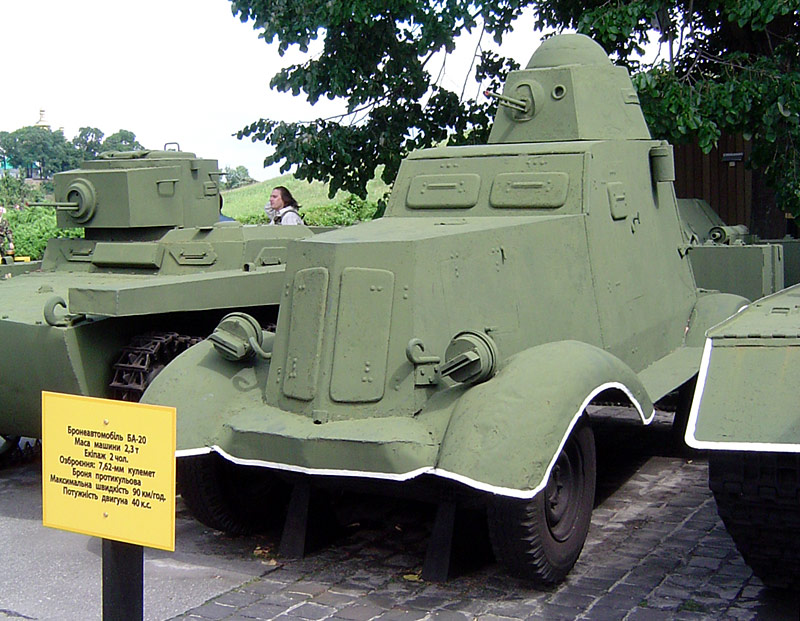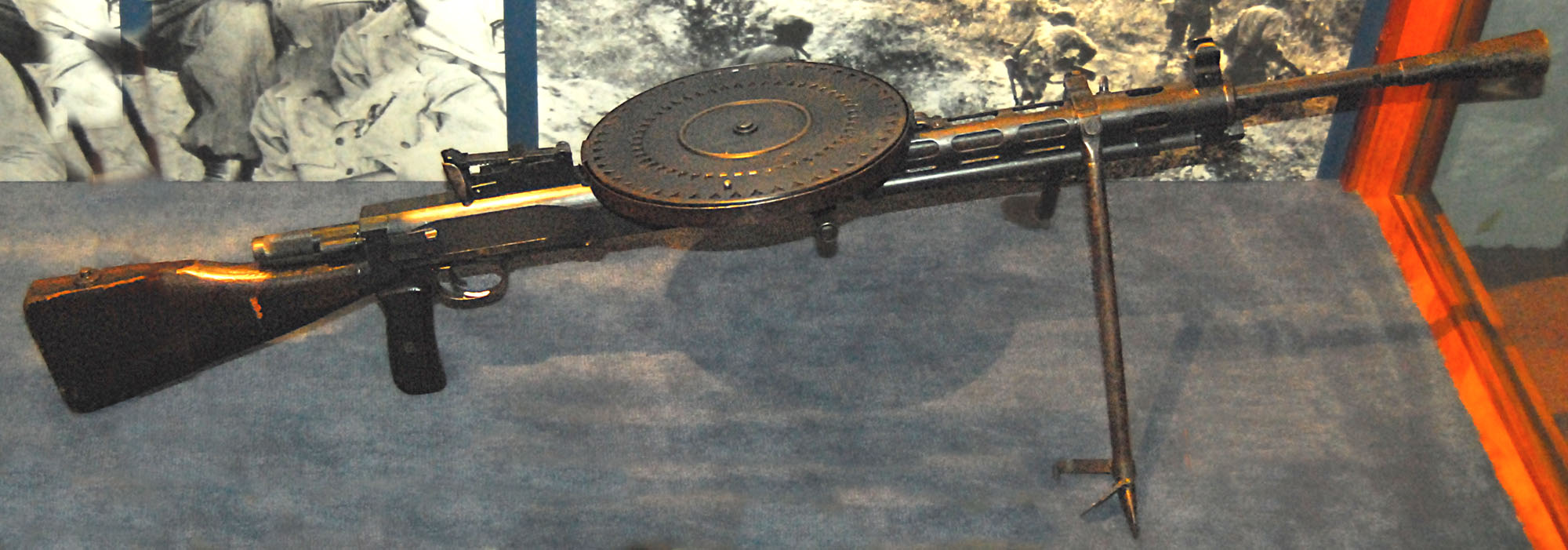|
BA-30
The BA-30 was a Soviet half-track armored car developed in 1937. Only a small number were built. Developments Developed at the NATI Institute, it was hoped that the BA-30 would be an improvement on the off-road performance of the previous BA series and was based on the chassis of the NATI-3 half-tracked transporter, whereas its armored hull was fully welded like the BA-20. The tracks on the BA-30 used 4 small and two large wheels, along with one return roller which was also incorporated on the NATI-3 and GAZ-60. When used in snowy environments two skis could be added to the front wheels. The BA-30 was noted for having good performance over varying terrains. It was fitted with a 71-TK-1 radio with its antenna on the hull, armed with a 7.62 DT machine gun, while the vehicle needed manning by a crew of three. Unapproved Only a few BA-30s were built and tested, with some taking part in the Winter War The Winter War,, sv, Vinterkriget, rus, ąŚąĖ╠üą╝ąĮčÅčÅ ą▓ąŠą╣ąĮą ... [...More Info...] [...Related Items...] OR: [Wikipedia] [Google] [Baidu] |
Half-track
A half-track is a civilian or military vehicle with regular wheels at the front for steering and continuous tracks at the back to propel the vehicle and carry most of the load. The purpose of this combination is to produce a vehicle with the cross-country capabilities of a tank and the handling of a wheeled vehicle. Performance The main advantage of half-tracks over wheeled vehicles is that the tracks reduce the pressure on any given area of the ground by spreading the vehicle's weight over a larger area, which gives it greater mobility over soft terrain like mud and snow, while they do not require the complex steering mechanisms of fully tracked vehicles, relying instead on their front wheels to direct the vehicle, augmented in some cases by track braking controlled by the steering wheel. It is not difficult for someone who can drive a car to drive a half-track, which is a great advantage over fully tracked vehicles, which require specialized training. Half-tracks thus facil ... [...More Info...] [...Related Items...] OR: [Wikipedia] [Google] [Baidu] |
Half-tracks Of The Interwar Period
A half-track is a civilian or military vehicle with regular wheels at the front for steering and continuous tracks at the back to propel the vehicle and carry most of the load. The purpose of this combination is to produce a vehicle with the cross-country capabilities of a tank and the handling of a wheeled vehicle. Performance The main advantage of half-tracks over wheeled vehicles is that the tracks reduce the pressure on any given area of the ground by spreading the vehicle's weight over a larger area, which gives it greater mobility over soft terrain like mud and snow, while they do not require the complex steering mechanisms of fully tracked vehicles, relying instead on their front wheels to direct the vehicle, augmented in some cases by track braking controlled by the steering wheel. It is not difficult for someone who can drive a car to drive a half-track, which is a great advantage over fully tracked vehicles, which require specialized training. Half-tracks thus fa ... [...More Info...] [...Related Items...] OR: [Wikipedia] [Google] [Baidu] |
DT Machine Gun
The Degtyaryov machine gun (russian: ą¤čāą╗ąĄą╝čæčé ąöąĄą│čéčÅčĆčæą▓a ą¤ąĄčģąŠčéąĮčŗą╣, Pulemyot Degtyaryova Pekhotny literally: "Degtyaryov's infantry machine gun") or DP-27/DP-28 is a light machine gun firing the 7.62├Ś54mmR cartridge that was primarily used by the Soviet Union, with service trials starting in 1927, followed by general deployment in 1928. Besides being the standard Soviet infantry light machine gun (LMG) during World War II, with various modifications it was used in aircraft as a flexible defensive weapon, and it equipped almost all Soviet tanks in WWII as either a flexible bow machine gun or a co-axial machine gun controlled by the gunner. It was improved in 1943 producing the DPM, but it was replaced in 1946 with the RP-46 which improved on the basic DP design by converting it to use belt feed. The DP machine gun was supplemented in the 1950s by the more modern RPD machine gun and entirely replaced in Soviet service by the general purpose PK machine gun in t ... [...More Info...] [...Related Items...] OR: [Wikipedia] [Google] [Baidu] |
Gasoline Engine
A petrol engine (gasoline engine in American English) is an internal combustion engine designed to run on petrol (gasoline). Petrol engines can often be adapted to also run on fuels such as liquefied petroleum gas and ethanol blends (such as ''E10'' and ''E85''). Most petrol engines use spark ignition, unlike diesel engines which typically use compression ignition. Another key difference to diesel engines is that petrol engines typically have a lower compression ratio. Design Thermodynamic cycle Most petrol engines use either the four-stroke Otto cycle or the two-stroke cycle. Petrol engines have also been produced using the Miller cycle and Atkinson cycle. Layout Most petrol-powered piston engines are straight engines or V engines. However, flat engines, W engines and other layouts are sometimes used. Wankel engines are classified by the number of rotors used. Compression ratio Cooling Petrol engines are either air-cooled or water-cooled. Ignition Petr ... [...More Info...] [...Related Items...] OR: [Wikipedia] [Google] [Baidu] |
Soviet Union
The Soviet Union,. officially the Union of Soviet Socialist Republics. (USSR),. was a List of former transcontinental countries#Since 1700, transcontinental country that spanned much of Eurasia from 1922 to 1991. A flagship communist state, it was nominally a Federation, federal union of Republics of the Soviet Union, fifteen national republics; in practice, both Government of the Soviet Union, its government and Economy of the Soviet Union, its economy were highly Soviet-type economic planning, centralized until its final years. It was a one-party state governed by the Communist Party of the Soviet Union, with the city of Moscow serving as its capital as well as that of its largest and most populous republic: the Russian Soviet Federative Socialist Republic, Russian SFSR. Other major cities included Saint Petersburg, Leningrad (Russian SFSR), Kyiv, Kiev (Ukrainian Soviet Socialist Republic, Ukrainian SSR), Minsk (Byelorussian Soviet Socialist Republic, Byelorussian SSR), Tas ... [...More Info...] [...Related Items...] OR: [Wikipedia] [Google] [Baidu] |
BA-20
The BA-20 (russian: Broneavtomobil 20, italic=yes) was an armored car developed in the Soviet Union in 1934. It was intended to replace the FAI and its field trials were completed in 1935. The BA-20 was then used in the early stages of World War II. Design and production The BA-20 armored car was developed in 1934 for use by HQ staffs, reconnaissance and communications units. It was derived from the civilian GAZ-M1 car using its chassis, which was itself a modified version of a Ford design, produced by the Nizhny Novgorod-based vehicle manufacturer GAZ. Full production of the BA-20 started in 1935. The chassis was built at the Nizhny Novgorod factory; the body was built at the Vyksinskiy plant, where final assembly of the BA-20 occurred as well. Service The principal use of the BA-20 was as a scout vehicle. The BA-20's tires were designed to be resistant to bullets and shrapnel by the simple expedient of filling them with spongey rubber. A variant, the BA-20ZhD, could travel ... [...More Info...] [...Related Items...] OR: [Wikipedia] [Google] [Baidu] |
Winter War
The Winter War,, sv, Vinterkriget, rus, ąŚąĖ╠üą╝ąĮčÅčÅ ą▓ąŠą╣ąĮą░╠ü, r=Zimnyaya voyna. The names SovietŌĆōFinnish War 1939ŌĆō1940 (russian: link=no, ąĪąŠą▓ąĄ╠üčéčüą║ąŠ-čäąĖąĮčüą║ą░čÅ ą▓ąŠą╣ąĮą░╠ü 1939ŌĆō1940) and SovietŌĆōFinland War 1939ŌĆō1940 (russian: link=no, ąĪąŠą▓ąĄ╠üčéčüą║ąŠ-čäąĖąĮą╗čÅąĮą┤čüą║ą░čÅ ą▓ąŠą╣ąĮą░╠ü 1939ŌĆō1940) are often used in Russian historiographybr>ąÆ.ąØ. ąæą░čĆčŗčłąĮąĖą║ąŠą▓. ą×čé ą┐čĆąŠčģą╗ą░ą┤ąĮąŠą│ąŠ ą╝ąĖčĆą░ ą║ ąŚąĖą╝ąĮąĄą╣ ą▓ąŠą╣ąĮąĄ. ąÆąŠčüč鹊čćąĮą░čÅ ą┐ąŠą╗ąĖčéąĖą║ą░ ążąĖąĮą╗čÅąĮą┤ąĖąĖ ą▓ 1930ŌĆōąĄ ą│ąŠą┤čŗ. ąĪą░ąĮą║čé-ą¤ąĄč鹥čĆą▒čāčĆą│, 1997.; ą×.ąö. ąöčāą┤ąŠčĆąŠą▓ą░. ąØąĄąĖąĘą▓ąĄčüčéąĮčŗąĄ čüčéčĆą░ąĮąĖčåčŗ ąŚąĖą╝ąĮąĄą╣ ą▓ąŠą╣ąĮčŗ. In: ąÆąŠąĄąĮąĮąŠ-ąĖčüč鹊čĆąĖč湥čüą║ąĖą╣ ąČčāčĆąĮą░ą╗. 1991. Ōä¢9.; ąŚąĖą╝ąĮčÅčÅ ą▓ąŠą╣ąĮą░ 1939ŌĆō1940. ąÜąĮąĖą│ą░ ą┐ąĄčĆą▓ą░čÅ. ą¤ąŠą╗ąĖčéąĖč湥čüą║ą░čÅ ąĖčüč鹊čĆąĖčÅ. ą£., 1998. ŌĆō ; ttp://www.otvaga2004.narod.ru/photo/winterwar/wwar1.htm ą£. ąÜąŠą╗ąŠą╝ąĖąĄčå. ąóą░ąĮą║ąĖ ą▓ ąŚąĖą╝ąĮąĄą╣ ą▓ąŠą╣ąĮąĄ 19 ... [...More Info...] [...Related Items...] OR: [Wikipedia] [Google] [Baidu] |
World War II Armoured Cars
In its most general sense, the term "world" refers to the totality of entities, to the whole of reality or to everything that is. The nature of the world has been conceptualized differently in different fields. Some conceptions see the world as unique while others talk of a "plurality of worlds". Some treat the world as one simple object while others analyze the world as a complex made up of many parts. In ''scientific cosmology'' the world or universe is commonly defined as " e totality of all space and time; all that is, has been, and will be". '' Theories of modality'', on the other hand, talk of possible worlds as complete and consistent ways how things could have been. ''Phenomenology'', starting from the horizon of co-given objects present in the periphery of every experience, defines the world as the biggest horizon or the "horizon of all horizons". In ''philosophy of mind'', the world is commonly contrasted with the mind as that which is represented by the mind. ''Th ... [...More Info...] [...Related Items...] OR: [Wikipedia] [Google] [Baidu] |
World War II Armoured Fighting Vehicles Of The Soviet Union
In its most general sense, the term "world" refers to the totality of entities, to the whole of reality or to everything that is. The nature of the world has been conceptualized differently in different fields. Some conceptions see the world as unique while others talk of a "plurality of worlds". Some treat the world as one simple object while others analyze the world as a complex made up of many parts. In '' scientific cosmology'' the world or universe is commonly defined as " e totality of all space and time; all that is, has been, and will be". '' Theories of modality'', on the other hand, talk of possible worlds as complete and consistent ways how things could have been. ''Phenomenology'', starting from the horizon of co-given objects present in the periphery of every experience, defines the world as the biggest horizon or the "horizon of all horizons". In ''philosophy of mind'', the world is commonly contrasted with the mind as that which is represented by the mind. ''T ... [...More Info...] [...Related Items...] OR: [Wikipedia] [Google] [Baidu] |






